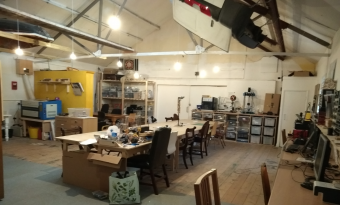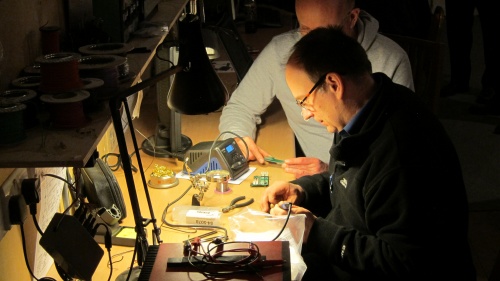Main Room
The main hub of the Makerspace, this room houses the dust-free crafts, soldering, laser cutters, computers, and 3D printers.
Work Tables
In theory the tables are meant to be kept as clear as possible, but that is a rule often skipped. Bear in mind anything left out may be moved, hacked at, or eaten, depending on who or what finds it first. The main table has power and Ethernet, so preference should be given to anyone needing that.
The Craftwork area (by Palletron) currently has no Ethernet and relies on extension leads, but is usually quieter and often more productive to work at! The convention is that messy or smelly activities, eg spray painting or dust-free wood finishing, takes place here, away from the electronics. A lightweight spray booth is under construction, pending extraction integration, for now we have a few cardboard boxes and fakir's beds. Dusty craft is banished to the Workshop.
The Craft and Soldering bench tools are not interchangeable. They must be returned to the correct rack, and ideally in the right place! Some of the Craftwork tools are very specific in purpose, if you do not know what they are, ask before using them - some are more delicate than they appear. Beware of the cutters here, the blades are often changed and are genuinely razor sharp.
Workbench
The soldering stations along the wall are equipped with all the essential equipment you'd expect for the activity, and usually anything else you might need is either on the tool rack at the end or in a box nearby. If you want to learn the fine art of soldering, we have a decent tutorial. Towards the door the soldering stations metamorphose into raspberry pi stations, and one of the PCs (Left) is currently set up here.
3D Printers
We have a range of 3D printers, but usually you will want to use Turnigy or Velleman, as the others are in various combinations of 'quirky', 'vintage' and 'in bits'. For details on these and how to use them, there is a dedicated wiki page.
Laser Cutters
The Lasers have their own page - consult here for settings, options and tips, and of course add your own. In a nutshell, images provided to the Laser software in acceptable formats (usually vector) are etched or cut into a range of materials. They can be used for almost anything - signs, decorations, stencils, wooden models, papercraft, leatherwork, or even lacemaking!
Computers
The PC on the end of the soldering bench, aka Left, is set up dual boot with Windows 10 and Linux Mint. It will hopefully be able to drive the vinyl cutter but we are awaiting test results to see if that is possible. In addition to the usual loadout, it also has Inventor 2019 installed.
The other PC, aka Right, is just Windows 10. Both of them are set up with commonly needed software, for graphics, modelling, 3d printing, and laser cutting. If you need to add more, use Chocolatey to install it if possible.
Any computer on the network, including a device of your own, can access the lasers and 3d printers, so use of one of these is not essential, but bear in mind that the laser software is windows only. If you use one of these PCs for driving the lasers then it is usually best to prepare files beforehand as DXF or SVG, then just import them into RDWorks/Thunderlaser to cut. See the Laser page for more information.

